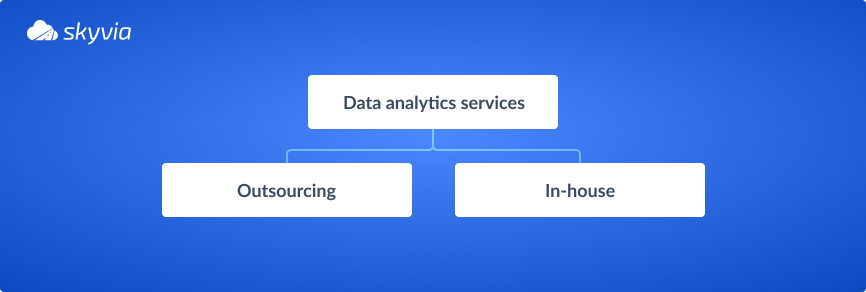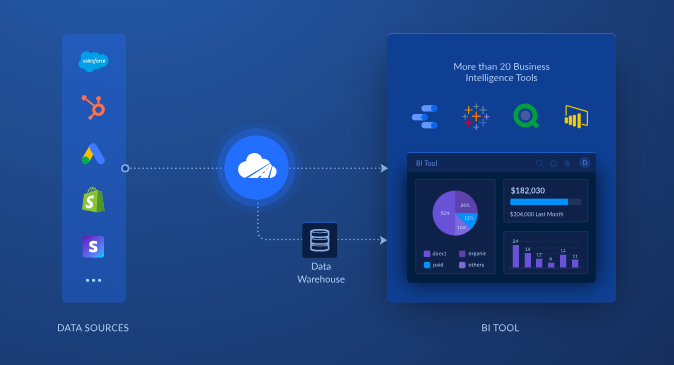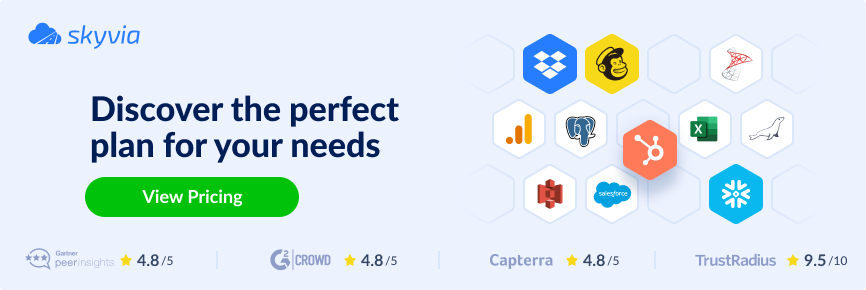It’s not a secret that data analytics might cost companies an arm and a leg. Even though it helps to predict future sales, boost customer retention, increase supply chain efficiency, protect against fraud, and bring other benefits, it’s still challenging to calculate its ROI and evaluate whether data analytics spending is reasonable.
The good news is that it’s possible to find other ways to assess the impact and reduce the cost of data analytics. This article reviews several practical approaches for that, so it’s time to reveal the secrets!
Table of Contents
- What Is Data Analytics and Why Does It Matter?
- How Data Analytics Can Transform Your Business Operations
- The ROI of Data Analytics: Is Your Company Investing Wisely?
- Unpacking the Key Factors Affecting Data Analytics Costs
- Why Skyvia is the Go-To Platform for Cost-Effective Data Analytics
- Wrapping Up
What Is Data Analytics and Why Does It Matter?
The power of data analysis is its ability to convert raw data into valuable insights. It comes in 4 fundamental forms:
- Descriptive analytics – uses historical data to assess how things were going in the past.
- Diagnostic analytics – scans existing data to find causes of past events.
- Predictive analytics – uses data together with statistical models and machine learning to predict future outcomes.
- Prescriptive analytics – provides companies with optimal solutions for future strategies.
Data analytics is used in many sectors, ranging from entertainment to manufacturing. To better understand what data analytics is and what its role is, let’s review some examples.
- Advertising. Analysis of customer data and behavior allows marketers to develop personalized ad campaigns. This increases customer involvement and purchase intent.
- Manufacturing. Data analytics streamlines production by providing suggestions to optimize supply chain management.
- Transportation. Real-time analytics evaluates the traffic on possible routes and suggests the fastest.
- Finance. Analysis of credit cardholders’ purchasing habits detects anomalies and prevents fraudulent transactions.
- Healthcare. Electronic sensors gathering patient data for analysis in real-time contribute to the detection of health hazards in a timely manner.
In 2023, 3 companies out 5 rely on data analytics, and more than 90% of those see tangible results. This number was considerably lower in previous years.
Overall, organizations feel more confident with data analytics results as they get data-driven insights into why something has happened and how to correct mistakes.
How Data Analytics Can Transform Your Business Operations
The popularity of data analytics isn’t out of the blue – it has the incredible power to transform chunks of base metals (raw data) into gold. Just like alchemists did!
This gold for companies is the advancement of:
- business operations
- customer experiences
- products
Starbucks Example
Let’s look at transformations brought by data analytics in Starbucks.
- Business operations. Analysis of current Starbucks store characteristics, including location, profits, demographics, and so on, predicts new favorable store locations.
- Customer experiences. The mobile app examines the history of orders and suggests new products that might interest a customer. This creates incredible personalization experiences for Starbucks’ audience.
- Products. Big data analysis of consumption habits in different areas allows Starbucks to create unique menu items.
Starbucks heavily relies on data analytics, and its net profit has doubled in the last 8 years. So why not start investing in data analytics today?
Business Transformation Tool
Consider the Skyvia cloud platform as a solution to make data analysis easier and faster in your organization. It’s suitable for a myriad of data-related tasks:
- Consolidate data in a DWH or database with the ELT and ETL tools for faster analytical queries.
- Activate data by sending it from a DWH back to business applications with Reverse ETL to use enriched data to improve in-app analytics and reporting.
What’s more, Skyvia allows you to perform automatic incremental updates once every few minutes to keep your data in a central repository that is always up-to-date. This is incredibly useful for those entangled in near-real-time data analytics. Try out how Skyvia works!
The ROI of Data Analytics: Is Your Company Investing Wisely?
Measuring ROI for data analytics is not the same as measuring ROI for marketing. It’s much more complex!
Organizations usually struggle to highlight data analytics’ impact as the monetary value. So, they often question themselves:
Are we investing wisely in data analytics?
Is the cost of data analytics fair enough?
What should we do to calculate ROI for analytics?
Do we have highly qualified data analysts?
ROI Formula
To assess the impact of investment, the ROI formula is used.
(Net Profit / Investment) * 100
In the case of data analytics, though, the problem is calculating the resulting net profit. It’s practically impossible to evaluate it because it intersects with marketing and sales outcomes.
Calculating the investment in data analytics is much easier. It mainly includes the cost of technological solutions and human resources.
Software
Processing modern-paced zettabytes of data manually is impossible. It could take millions of years and dollars!
Businesses have no time to wait, so they use data analytics software to speed up things.
The cost of data analytics software usually includes:
- licensing
- storage and computing expenses
Popular analytics solutions, such as Tableau, Looker, Power BI, and RapidMiner, have different licensing and pricing models. The overall cost depends on the chosen plan with the needed number of users and functionality.
Expenses for storage and computing capacity depend on whether a company uses on-premises or cloud services. The first case includes all the costs associated with the on-site architecture and its maintenance. For cloud services, the cost depends on the particular data warehouse provider and available pricing models, where spending usually increases proportionally with data growing. Obviously, utilizing a data warehouse for storage and computing is a preferable option as it allows for scalability and a pay-as-you-go pricing model.
To bring data from cloud apps into a data warehouse, such services as Skyvia are needed. It has a free plan, so you can try its functionality now!
Let’s calculate the minimum monthly cost of data analytics software:
- $0 for data visualization and analysis
- $100 for data warehouse on BigQuery when querying occasionally
- $0 for Skyvia
Min. software cost – $115/month
Services
Some small and medium-sized businesses mightn’t need analytics on a regular basis. Meanwhile, companies working with high-volume big data prefer real-time analytics. Depending on the data flows, in-house or outsourced analytical services could be more appropriate.

Let’s look at those two types of data analytics services, along with their advantages and drawbacks.
| Outsourcing | In-house |
|---|---|
| When companies decide to pass over data analytics tasks to third-party agencies, it’s called outsourcing. Pros: – Employ highly qualified analysts with years of experience in different sectors. – Provide services on-demand, ensuring flexibility and scalability in case of data volume variation. Cons: – Might respond with delays, which creates communication issues. – Associates with security risks as data is processed on the third-party side. | When companies hire a dedicated employee occupied with analytical tasks, the service takes place in-house. Pros: – Adds certainty. – Levels up decision-making and security. Cons: – In case the data amount grows or the number of tasks increases, companies must employ extra personnel to cope with the flow. This prevents scalability and flexibility. |
The average price for analytical services may range from several hundred to thousands of dollars, depending on the preferred model.
Employee Cost
If you rely on in-house specialists, employee costs depend on the average salary rates. A data analyst may get around $30,000 in Europe and $90,000 in the US on average, depending on the expertise and skills.
Min. employee cost – $2500/month
Calculating investment isn’t that hard while extracting the net profit numbers is difficult. So, we suggest some alternative solutions.
- Take the general ROI formula considering the total investment and total net profit (marketing, sales, data analytics, etc.).
- Define other metrics for measuring data analytics effectiveness – faster decision-making, higher profits in other departments, greater market share, etc.
Getting back to the question of whether you’re investing wisely in the data analytics cost – the answer is “It depends!”. It depends on many factors described in the next section.
Unpacking the Key Factors Affecting Data Analytics Costs
To comprehend whether you spend enough or too much money on data analytics, let’s review the key factors affecting it.
1. Amount and Reliability of Your Data
When the number of business operations augments, it’s necessary to respond immediately. Your technological base should be easily scalable and resistant to high load. Luckily, modern data warehouses offer that flexibility for storage and processing purposes.
- BigQuery data warehouse and analytics platform costs start from $0.02 per GiB per month for storage. Computing pricing starts from $6.25 with the on-demand model and $0.04 slot/hour on the capacity-based analytics pricing model. Skyvia connects to BigQuery to transfer data to or from there.
- With Amazon Redshift, you can start at $0.25 per hour and scale up to petabytes of data. Skyvia connects to Redshift for loading data to and from it.
- Snowflake fuels the visualization of insights with reporting, data processing, and forecasting in the same data warehouse. The pricing starts at $2.60 per credit for the Standard edition with elastic computing and storage. Skyvia connects with Snowflake to transfer data to or from there.
As you see, those are the approximate costs of popular data warehouse providers. You can calculate the sum for data storage and management based on your current or forecasted data load.
2. Data Analytics Tools that Fit Your Needs
The data analytics market is oligopolized – there are several major players in it. To choose the most appropriate one, let’s look at some popular solutions with their features and costs.
- Tableau. It handles millions of data rows to generate visualizations and reports. The tool is mobile-friendly, offering apps for Android and iOS platforms. The pricing ranges between $12 and $70 per month per person.
- Power BI. It can transform and clean organizational data to later convert it into visually appealing dashboards and charts. Power BI also perfectly integrates with other Microsoft products, making it a convenient data analytics solution. The prices range from $0.00 for the free edition to $29.90 for the Premium package.
- Apache Spark. This open-source software processes and analyzes big data.
3. Total Cost of Ownership for Data Analytics Software
We’ve already examined costs for various software types, but let’s gather all these scattered pieces of information together to calculate the parameter Total Cost of Ownership. It considers software and all its associated costs over time:
- Initial setup includes the prices for the license, software deployment, DWH setup, user training, and infrastructure update if needed.
- Operating costs include software and DWH maintenance expenses, energy consumption, technical support, and upgrades.
You can calculate TOC in the long perspective by multiplying operating costs by the number of years and adding them to the initial investment. This is helpful when allocating budgets and working on long-term strategies.
4. Hidden Costs of Custom Development
This factor is primarily associated with the unpredictable nature of business development. When the amount of data rapidly increases, operational capacities should immediately address this.
A rapid outburst of data amounts means higher costs for storage, computing power, and analytics services. It might also involve more data analysts and service outsourcing.
5. Organizational Flexibility and Openness to Transformation
Although this factor is the last on the list, it’s not the least significant. On the contrary, it’s the most important thing to start with before implementing data analytics. Why so?
If organizational culture isn’t fancy to transform, data analysis will make no sense. Such a ‘resistance to change’ makes data analytics efforts and investments go in vain.
Why Skyvia is the Go-To Platform for Cost-Effective Data Analytics
The value of high-quality data analysis can’t be overestimated. Organizations strive to obtain insights from their data as fast as possible in order to remain competitive in the red ocean markets.
Business data is usually fragmented because it comes from cloud apps and on-premises databases. To perform analytics well, it’s worth moving all data to a cloud data warehouse. It’s the best platform offering higher performance for analytical queries.
If you’re wondering how to consolidate your data on a single platform – Skyvia is the answer. It offers all the necessary tools to move your data from cloud apps or databases to a data warehouse.
Skyvia can connect to the following databases and data warehouse easily:
- AlloyDB
- Amazon RedShift
- Azure Synapse Analytics
- Google BigQuery
- MySQL
- Oracle
- PostgreSQL
- Snowflake
- SQL Server

The Replication tool of Skyvia uses the ELT concept: extracts data from the supported sources and sends it to the data warehouse of your choice. It also offers scheduling so that you can set up data transfer every few minutes to get insights from real-time analytics.

Skyvia’s Import integration tool comes into play when it’s necessary to load data from a DWH to cloud apps. That way, enriched data improves the quality of the in-app analytics and reporting. It relies on the ETL process and offers powerful transformation settings, allowing you to bring data from one source to another even if their data structures differ.
All these operations for your business can be done for free. Explore how Skyvia works!

Wrapping Up
Investment in data analytics is necessary if your company obtains tangible benefits. At the same time, don’t exaggerate the costs for software and human resources. Rely on in-house or outsourcing professionals, depending on the demand for analytics. Choose those tools that would correspond to the expected data load and querying. Consider Skyvia and its power to connect dispersed resources and prepare a strong base for a qualitative approach toward data analysis!

